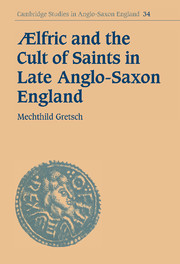46 results
15 - Literacy and the uses of the vernacular
-
-
- Book:
- The Cambridge Companion to Old English Literature
- Published online:
- 05 May 2013
- Print publication:
- 02 May 2013, pp 273-294
-
- Chapter
- Export citation
Contributors
-
-
- Book:
- The Cambridge Companion to Old English Literature
- Published online:
- 05 May 2013
- Print publication:
- 02 May 2013, pp vii-viii
-
- Chapter
- Export citation
Historiography and literary patronage in late Anglo-Saxon England: the evidence of Æthelweard's Chronicon
-
- Journal:
- Anglo-Saxon England / Volume 41 / December 2012
- Published online by Cambridge University Press:
- 10 July 2013, pp. 205-248
- Print publication:
- December 2012
-
- Article
- Export citation
Æthelthryth of Ely in a lost calendar from Munich
-
- Journal:
- Anglo-Saxon England / Volume 35 / December 2006
- Published online by Cambridge University Press:
- 29 June 2007, pp. 159-177
- Print publication:
- December 2006
-
- Article
- Export citation
Contents
-
- Book:
- Aelfric and the Cult of Saints in Late Anglo-Saxon England
- Published online:
- 22 September 2009
- Print publication:
- 19 January 2006, pp v-vi
-
- Chapter
- Export citation
Bibliography
-
- Book:
- Aelfric and the Cult of Saints in Late Anglo-Saxon England
- Published online:
- 22 September 2009
- Print publication:
- 19 January 2006, pp 248-257
-
- Chapter
- Export citation
List of abbreviations
-
- Book:
- Aelfric and the Cult of Saints in Late Anglo-Saxon England
- Published online:
- 22 September 2009
- Print publication:
- 19 January 2006, pp x-xii
-
- Chapter
- Export citation

Aelfric and the Cult of Saints in Late Anglo-Saxon England
-
- Published online:
- 22 September 2009
- Print publication:
- 19 January 2006
1 - Ælfric's sanctorale and the Benedictional of Æthelwold
-
- Book:
- Aelfric and the Cult of Saints in Late Anglo-Saxon England
- Published online:
- 22 September 2009
- Print publication:
- 19 January 2006, pp 1-20
-
- Chapter
- Export citation
4 - Benedict: father of monks – and what else?
-
- Book:
- Aelfric and the Cult of Saints in Late Anglo-Saxon England
- Published online:
- 22 September 2009
- Print publication:
- 19 January 2006, pp 127-156
-
- Chapter
- Export citation
5 - Swithun and Æthelthryth: two saints ‘of our days’
-
- Book:
- Aelfric and the Cult of Saints in Late Anglo-Saxon England
- Published online:
- 22 September 2009
- Print publication:
- 19 January 2006, pp 157-231
-
- Chapter
- Export citation
6 - Epilogue
-
- Book:
- Aelfric and the Cult of Saints in Late Anglo-Saxon England
- Published online:
- 22 September 2009
- Print publication:
- 19 January 2006, pp 232-247
-
- Chapter
- Export citation
2 - Gregory: the apostle of the English
-
- Book:
- Aelfric and the Cult of Saints in Late Anglo-Saxon England
- Published online:
- 22 September 2009
- Print publication:
- 19 January 2006, pp 21-64
-
- Chapter
- Export citation
General index
-
- Book:
- Aelfric and the Cult of Saints in Late Anglo-Saxon England
- Published online:
- 22 September 2009
- Print publication:
- 19 January 2006, pp 260-263
-
- Chapter
- Export citation
3 - Cuthbert: from Northumbrian saint to saint of all England
-
- Book:
- Aelfric and the Cult of Saints in Late Anglo-Saxon England
- Published online:
- 22 September 2009
- Print publication:
- 19 January 2006, pp 65-126
-
- Chapter
- Export citation
Frontmatter
-
- Book:
- Aelfric and the Cult of Saints in Late Anglo-Saxon England
- Published online:
- 22 September 2009
- Print publication:
- 19 January 2006, pp i-iv
-
- Chapter
- Export citation
Index of manuscripts
-
- Book:
- Aelfric and the Cult of Saints in Late Anglo-Saxon England
- Published online:
- 22 September 2009
- Print publication:
- 19 January 2006, pp 258-259
-
- Chapter
- Export citation
Preface
-
- Book:
- Aelfric and the Cult of Saints in Late Anglo-Saxon England
- Published online:
- 22 September 2009
- Print publication:
- 19 January 2006, pp vii-ix
-
- Chapter
- Export citation
The Taunton Fragment: a new text from Anglo-Saxon England
-
- Journal:
- Anglo-Saxon England / Volume 33 / December 2004
- Published online by Cambridge University Press:
- 08 March 2005, pp. 145-193
- Print publication:
- December 2004
-
- Article
- Export citation
Cambridge, Corpus Christi College 57: a witness to the early stages of the Benedictine reform in England?
-
- Journal:
- Anglo-Saxon England / Volume 32 / December 2003
- Published online by Cambridge University Press:
- 12 August 2004, pp. 111-146
- Print publication:
- December 2003
-
- Article
- Export citation

